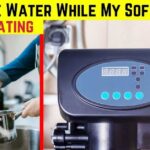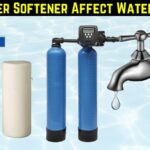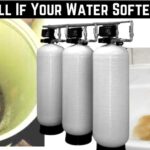How much water does a water softener use in regeneration? It is a question that many homeowners have and one that deserves an answer.
In this post, we’ll look at how much water a typical softener uses and some ways to reduce the water used. So, read on to learn more!
How Much Water Does A Water Softener Use During Regeneration?
The answer to this question depends on the size of your softener. A standard 42,000-grain softener resin tank will use approximately 27 gallons of water to regenerate.
This is because the resin beads in the softener need cleaning of any accumulated minerals before they can work properly again.
If you have a smaller water softener system, it will use less water during regeneration. Some high-efficiency models can use as little as 3 gallons of water for renewal.
For example, some units have an internal reserve tank with an extra water supply for regeneration, while others do not.
You can check your model’s manual to determine how much water it uses for regeneration.
Once the regeneration process is complete, the softened water is returned to your home and can be used again.
As such, the net impact of regeneration on your water usage is relatively small.
While the amount of water used during regeneration is small, it is still essential to be mindful of your impact.
You can help minimize your use and protect our valuable resources by taking simple steps.
If you are concerned about the amount of water, you can do a few things to reduce it.
Correct Size
Make sure your unit has the correct size for your home. A unit that is too small will regenerate more often than necessary, using more water in the process.
Set Regeneration

One option is to set your water softener to regenerate only when needed.
It can be done using a city water usage monitor that tracks how much water you use and restores the softener brine tank accordingly.
Efficient Regeneration
Another option is to choose a soft water softener with an efficient regeneration cycle. Some models use less water during regeneration by recalculating the rinse water back into the brine tank.
This means less water is wasted, and your regeneration cycle will be shorter.
Suppose you are concerned about conserving average household water usage. In that case, there are ways to minimize the water used during regeneration.
Choose a model with an efficient regeneration cycle or set your softener to regenerate only when necessary to reduce the flow of water waste.
How Does A Water Softener Regenerate?
A softener regenerates when it is full of calcium and magnesium ions. These ions are exchanged for sodium or potassium ions and flushed out of the system.
The regeneration process typically occurs at night when water usage is low.
During regeneration, salt (sodium ion) is added to the system, and freshwater rinses away the calcium and magnesium minerals.
The sodium or potassium ions take their place. The outdoor water softener is ready to continue softening water for your home.
If you have any questions about how your water softener regenerates or if it may be time for regeneration, contact your local water treatment professional.
Why Does A Water Softener Regenerate Or Backwash?
A softener is a device that use to remove hard minerals from water. These water minerals can cause problems in your home, including clogged house water pipes, fixtures, and dingy laundry.
A softener salt tank exchanges the hard minerals in your water for softer ones, like sodium or potassium.
Over time, the hard minerals can build up in the softener salt tank, causing it to become less effective.
The softener will regenerate or backwash to remove the water minerals. This process cleans out the hardness minerals and allows the softener to continue working correctly.
How Long Does Water Softener Regeneration Take?
The answer to this question depends on a few factors, including the size of your softener capacity, the type of regeneration cycle it uses, and the hardness of your water.
Typically, water softener regeneration steps can take 30 minutes to 2 hours.
If you have a large water softener resin tank or your water is very hard, it may take longer for the regeneration cycle to complete.
Conversely, the regeneration cycle may be shorter if you have a small softener unit or your water is relatively easy.
There are two types of softener regeneration processes:
Timed:- Timed regeneration cycles occur regularly, regardless of how much water has been used.
Demand:- Demand regeneration cycles only occur when the softener senses it needs to regenerate. Typically, the water hardness has increased, or the system has been used more than usual.
Demand regeneration cycles are generally more efficient than timed regeneration cycles, as they only occur when necessary.
However, they can sometimes take longer to complete if the water hardness or excess use of the system is very high.
Generally, you can expect your water softener regeneration time to take anywhere from 30 minutes to 2 hours.
What To Do If Water Softener Stuck In Regeneration Process?
If your water softener system is stuck in regeneration mode, you can do a few things to try and fix the issue.
First, check the unit’s control panel to ensure all the default settings are correct.
If everything looks good, you must check the brine tank to ensure it has enough salt bridges.
The next step is to check the drain line to ensure it isn’t clogged.
If everything is clear, you may need to call a professional to look at your water-softening system.
How Much Water Does A Softener Use?
Water tanks are one of the most common home equipment to improve water quality.
They are also one of the most misunderstood, with many people needing clarification on how they work or how much water they use.
Water tanks are highly efficient and use less water quality than other household appliances.
The average water softener only uses around 20 gallons per regeneration cycle.
If you have a family of four, your softener will use less than one gallon of water daily, making it a very low-water appliance.
So, you’re looking for a way to improve your soft water quality without using too much water. In that case, a softener is a great option!
What Would Cause Your Water Bill To Increase?
If your water bill has been increasing, there could be several reasons. One possibility is that you’ve been using more water than usual.
This could be due to filling up a pool, watering your lawn more often, or having guests who use your showers and toilets.
Another possibility is that there has been a flow rate increase from your water provider. It happens from time to time and usually isn’t a cause for alarm.
You can check with your provider to see if this is the case.
Finally, there could be a leak in your home’s plumbing.
This can be tricky to spot, but if you suspect a problem, you can contact a plumber to come and take a look.
A leaky pipe can waste a lot of water, so getting it fixed as soon as possible is essential.
If your water bill has been increasing and you need to figure out why these are a few possible explanations.
You can contact a professional plumber to get the right solution.
How To Tell If You Have Hard Water?
You can tell if you have hard water in a few ways. The most obvious way is to look for mineral deposits on your fixtures and appliances.
These deposits, called scale, can be challenging to remove and can cause damage to your fixtures and appliances over time.
You may also notice that your clothes feel stiff after washing in the hardest water or that your skin feels dry and irritated after bathing.
If you suspect you have hard water, you can have your water tested by a professional to confirm.
Another way to tell if you have hard water stains is to look at your plumbing.
Over time, tank water can cause a buildup of scale on the inside of pipes, restricting water flow and leading to clogs.
You may also notice that your water pressure is lower than usual.
If you have any concerns about your soft water, it is best to contact a professional or watch this video:
Conclusion: (How much water does a water softener use in regeneration?)
In conclusion, we know that the softener uses water during regeneration. This type of water cleans the resin bead and removes the hardness ions.
The amount of water used during regeneration can vary depending on the size of your unit but is typically around 20-30 gallons.
This information is helpful for you. Thanks for reading!
FAQs
How many gallons of water does a water softener waste?
A water softener can waste anywhere from 25 to 150 gallons of water per regeneration cycle, depending on the size and efficiency of the system. The water wasted is mainly due to the backwashing process, where the system flushes out accumulated mineral particles and regenerates the resin bed. However, some modern water softeners are designed to be more efficient and may use less water during regeneration.
Does a water softener drain during regeneration?
Yes, a water softener drains during the regeneration process. The regeneration cycle involves flushing out accumulated minerals and regenerating the resin bed, which requires the system to backwash and rinse with water. This results in the discharge of wastewater, which typically goes through a separate drain pipe or can be routed to a dedicated drain field.
Does water softener increase water usage?
No, a water softener does not increase water usage. A water softener can help reduce water usage by preventing mineral buildup in plumbing and appliances, which can lead to clogs and inefficiencies. Softened water also requires less soap and detergent to achieve the same cleaning results, which can further reduce water usage.
Why is there so much water in my water softener tank?
The amount of water in a water softener tank can vary depending on the type of system and its current operating stage. The excessive amount of water in the tank may indicate a problem, such as a malfunctioning valve or a leak in the system. The excess water could also be due to an overfilled brine tank or improper programming of the water softener. In some cases, the high water level may be a normal part of the regeneration process, where the tank fills with water before the brine solution is added to regenerate the resin bed.






